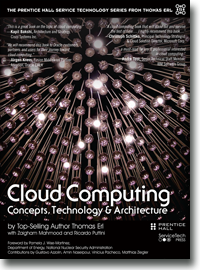Cloud Computing Patterns, Mechanisms > Basics > Origins and Influences > Technology Innovations
Technology Innovations
Established technologies are often used as inspiration and, at times, the actual foundations upon which new technology innovations are derived and built. This section briefly describes the pre-existing technologies considered primary influences on cloud computing.
Clustering
A cluster is a group of independent IT resources that are interconnected and work as a single system. System failure rates are reduced while availability and reliability are increased, since redundancy and failover features are inherent to the cluster.
A general prerequisite of hardware clustering is that its component systems have reasonably identical hardware and operating systems to provide similar performance levels when one failed component is to be replaced by another. Component devices that form a cluster are kept in synchronization through dedicated, high-speed communication links.
The basic concept of built-in redundancy and failover is core to cloud platforms. Clustering technology is explored further in Chapter 8 as part of the Resource Cluster mechanism description.
Grid Computing
A computing grid (or “computational grid”) provides a platform in which computing resources are organized into one or more logical pools. These pools are collectively coordinated to provide a high performance distributed grid, sometimes referred to as a “super virtual computer.” Grid computing differs from clustering in that grid systems are much more loosely coupled and distributed. As a result, grid computing systems can involve computing resources that are heterogeneous and geographically dispersed, which is generally not possible with cluster computing-based systems.
Grid computing has been an on-going research area in computing science since the early 1990s. The technological advancements achieved by grid computing projects have influenced various aspects of cloud computing platforms and mechanisms, specifically in relation to common feature-sets such as networked access, resource pooling, and scalability and resiliency. These types of features can be established by both grid computing and cloud computing, in their own distinctive approaches.
For example, grid computing is based on a middleware layer that is deployed on computing resources. These IT resources participate in a grid pool that implements a series of workload distribution and coordination functions. This middle tier can contain load balancing logic, failover controls, and autonomic configuration management, each having previously inspired similar-and several more sophisticated-cloud computing technologies. It is for this reason that some classify cloud computing as a descendant of earlier grid computing initiatives.
Virtualization
Virtualization represents a technology platform used for the creation of virtual instances of IT resources. A layer of virtualization software allows physical IT resources to provide multiple virtual images of themselves so that their underlying processing capabilities can be shared by multiple users.
Prior to the advent of virtualization technologies, software was limited to residing on and being coupled with static hardware environments. The virtualization process severs this software-hardware dependency, as hardware requirements can be simulated by emulation software running in virtualized environments.
Established virtualization technologies can be traced to several cloud characteristics and cloud computing mechanisms, having inspired many of their core features. As cloud computing evolved, a generation of modern virtualization technologies emerged to overcome the performance, reliability, and scalability limitations of traditional virtualization platforms.
As a foundation of contemporary cloud technology, modern virtualization provides a variety of virtualization types and technology layers that are discussed separately in Chapter 5.
Technology Innovations vs. Enabling Technologies
It is essential to highlight several other areas of technology that continue to contribute to modern-day cloud-based platforms. These are distinguished as cloud-enabling technologies, the following of which are covered in Chapter 5:
- Broadband Networks and Internet Architecture
- Data Center Technology
- (Modern) Virtualization Technology
- Web Technology
- Multitenant Technology
- Service Technology
Each of these cloud-enabling technologies existed in some form prior to the formal advent of cloud computing. Some were refi ned further, and on occasion even redefined, as a result of the subsequent evolution of cloud computing.

